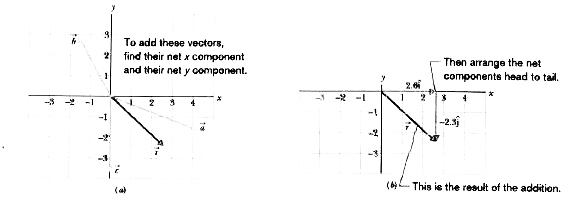shows the following three vectors:
→a=(4.2m)ˆi−(1.5m)ˆj,
→b=(−1.6m)ˆi+(2.9m)ˆj,
and →c=(−3.7m)ˆj.
What is their vector sum →r which is also shown ?
Text Solution
For x axis, we add the x components of →a,→band→c to get the x component of the vector sum →r:
rx=ax+bx+cx
=4.2m−1.6m+0=2.6m.
Similarly, for the y axis,
ry=ay+by+cy
=−1.5m+2.9m−3.7m=−2.3m.
We then combine these components of →r to write the vector in unit-vector notation:
→r=(2.6m)ˆi−(2.3m)ˆj,
where (2.6m)ˆi is the vector component of →r along the x axis and −(2.6m)ˆj is that along the y axis. shows one way to arrang ethese vector components to from →r. (Can you sketch the other way?)
We can also answer the equation by giving the magnitude and an angle for →r. the magnitude is
r=√(2.6m)2+(−2.3m)2≈3.5m
and the angle (measured from the + x direction) is
θ=tan−1(−2.3m2.6m)=−41∘,
where the minus sign means clockwise.

|
Updated on:21/07/2023
Topper's Solved these Questions
- BOOK - RESNICK AND HALLIDAYCHAPTER - VECTORS EXERCISE - CHECKPOINT5videos
VECTORS
- BOOK - RESNICK AND HALLIDAYCHAPTER - VECTORS EXERCISE - PROBLEMS34videos
VECTORS
- BOOK - RESNICK AND HALLIDAYCHAPTER - UNITS AND MEASUREMENT EXERCISE - PRACTICE QUESTIONS (MATRIX-MATCH)11videos
UNITS AND MEASUREMENT
- BOOK - RESNICK AND HALLIDAYCHAPTER - WAVE - IIEXERCISE - PRACTICE QUESTIONS (INTEGER TYPE)5videos
WAVE - II
Similar Questions
Knowledge Check
- Question 1 - Select One
If →a=ˆi+ˆj−ˆk,→b=−ˆi+2ˆj+2ˆkand→c=−ˆi+2ˆj−ˆk , then a unit vector normal to the vectors →a+→band→b−→c, is
AˆiBˆjCˆkDnone of these - Question 2 - Select One
If →A=−4ˆj+3ˆjand→B=2ˆi+5ˆjand→C=→A×→B, then the vector →C makes an angle of
A45∘ with x - axisB180∘ with y - axisC0∘ with z - axisD180∘ with z - axis - Question 3 - Select One
Let →a−2ˆi+ˆj+ˆk,→b=ˆi+2ˆj+ˆkand→c=2ˆi−3ˆj+4ˆk.A vector →r satisfying →r×→b=→c×→band→r.Veca=0 is
A−2ˆi=2ˆj+2ˆkB−2ˆi+ˆj+3ˆkC3ˆi+2ˆj+4ˆkDˆi−5ˆj+3ˆk
Let →a=ˆi+ˆj+√2ˆk,→b=b1ˆi+b2ˆj+√2ˆkand→c=5ˆi+ˆj+√2ˆk be three vectors such that the projection vector of →b on →a is →a.
If →a+→b perpendicular to →c, then ∣∣→b∣∣ is equal toView Solution(i) Find the sum of vectors →a=ˆi−2ˆj+ˆk,→b=−2ˆi+4ˆj+5ˆk, and →c=ˆi−ˆj−7ˆk (ii) Find the magnitude of the vector →a=3ˆi−2ˆj+6ˆk.
View SolutionIf →a=4ˆj+5ˆj−ˆk,→b=ˆi−4ˆj+4ˆk and →c=3ˆi+ˆj+ˆk Find a vector →d which is perpendicualr to both →a and →b and →d.→c = 21 .
View SolutionLet →a−2ˆi+ˆj+ˆk,→b=ˆi+2ˆj+ˆkand→c=2ˆi−3ˆj+4ˆk.A vector →r satisfying →r×→b=→c×→band→r.Veca=0 is
View SolutionLet →a=ˆi+ˆj+ˆk,→b=ˆi−ˆj+ˆkand→c=ˆi−ˆj−ˆk be three vectors. A vectors →v in the plane of →aand→b , whose projection on →cis1√3 is given by
View Solution

